Francis Scott Key and the National Anthem
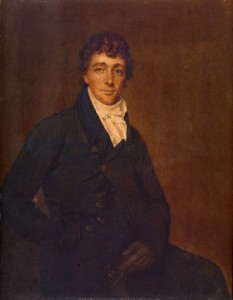
Key was a prominent lawyer from Frederick, Maryland who, through a sequence of incidents that occurred during the War of 1812, observed one of the most critical episodes in American history.
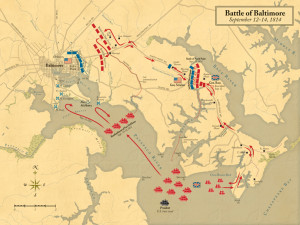
In fact, Ross and Cockburn had decided on a coordinated air and sea attack. Ross would land his troops at North Point, Maryland at the tip of the Patapsco Neck and make the short fifteen-mile march to the city. After the sixty-mile march on Washington, Ross reasoned that he would handle this much shorter distance with relative ease. Because the Patapsco was relatively shallow, the larger warships would not be able to enter the inner harbor area. Instead Cockburn would take the smaller frigates and bombardment vessels upriver to attack Fort McHenry and after extinguishing the guns of the fort, to bombard the city itself, hopefully leading to a major conflagration.
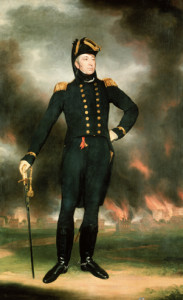
The British army regrouped briefly but within hours began marching briskly towards Washington. 1,200 men halted two miles from the Capitol, Ross continued into the city itself with 200 elite infantrymen. There was zero resistance, any remaining civilians remained inside their homes. The only remaining American activity in the city was the deliberate destruction of the Washington Navy Yard, flames visible on the already dark horizon. Several ships, naval equipment, ordinance and other shipbuilding materials were destroyed to keep them out of the hands of the British. Ross and Cockburn had already decided to burn any public buildings in the city and as the Navy Yard glowed a few miles away, Ross’ units took position around the US Capitol building. The Capitol building itself looked nothing like today’s domed edifice, instead it was two square sandstone blocks connected by a wooden passageway. Under construction since 1793, it was a costly and time- consuming process. The British entered the building, ascertained that no one was present and began smearing gunpowder paste on the walls of the South Wing. Once this was lit, paper and wooden furniture was added and within minutes an intense heat drove the arsonists to the North Wing where a magnificent library was quickly put to the torch. The entire building was soon engulfed in flames.
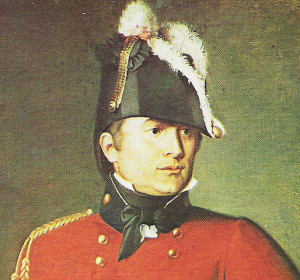
Next, Ross, Coburn and a column of men set out to what was known as the “President’s Mansion.” They entered the now deserted home and devoured the food and wine that was supposed to have been served to the President and his guests as that afternoon’s supper. After selecting a few souvenirs but nothing of any value as to avoid being charged with “looting”, soldiers quickly began to pile up furniture and soak mattresses with lamp oil. After some flame was acquired from a nearby tavern, an officer walked through the rooms of the mansion, igniting the makeshift kindling in each room. Madison’s former home was quickly ablaze, Ross, Cockburn and troops admiring their work from a short distance.
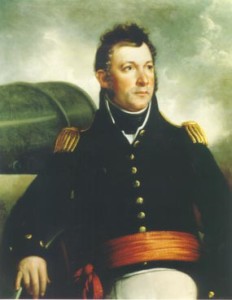
Fort McHenry, under the command of Major George Armistead, responded with over fifty cannons from the fort itself, as well as shore batteries on both sides of the river. Some of this fire was accurate enough to force Cochrane to move his ships out of range, approximately two miles away. Here he was content to blast away with his mortars, the Americans unable to reach the British ships. Armistead ordered his guns to cease fire, and the gun crews to take cover. British shells and rockets were landing on an average of over one per minute, by noon hundreds of projectiles had landed on or near the fort. The incendiary rockets were essentially harmless but an occasional mortar shell made its way into the fort and detonated with a tremendous explosion. One pierced the roof of the fort’s powder magazine but failed to detonate, had it exploded it would have blown up 300 hundred barrels of gunpowder, the fort and most of its inhabitants.
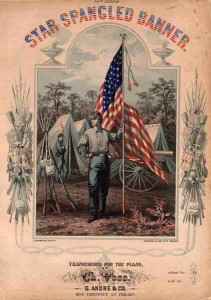
Although “The Star-Spangled Banner” remained popular during Key’s lifetime, it did not achieve official status for many years. Other songs, including “Hail, Columbia”, “America, the Beautiful” and “My Country, Tis of thee.” would be sung at public events and ceremonies, all achieving unofficial status. It would not be until a congressional resolution, signed by President Herbert Hoover in 1931 that the Star Spangled Banner would officially be named the national anthem.
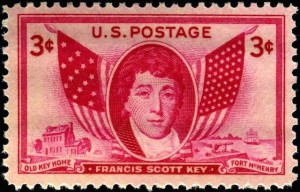
Key would return to his prestigious law practice in Washington. Thirty-five years old when he wrote “The Star Spangled Banner” he had already argued cases in front of the Supreme Court. He would represent many clients in some of the era’s most prominent legal cases. Key had close political ties to Andrew Jackson and would eventually be named the US Attorney for Washington, DC, a post he held until 1841. He died on January 11, 1843, aged 63.
Podcast: Play in new window | Download
Subscribe: RSS
